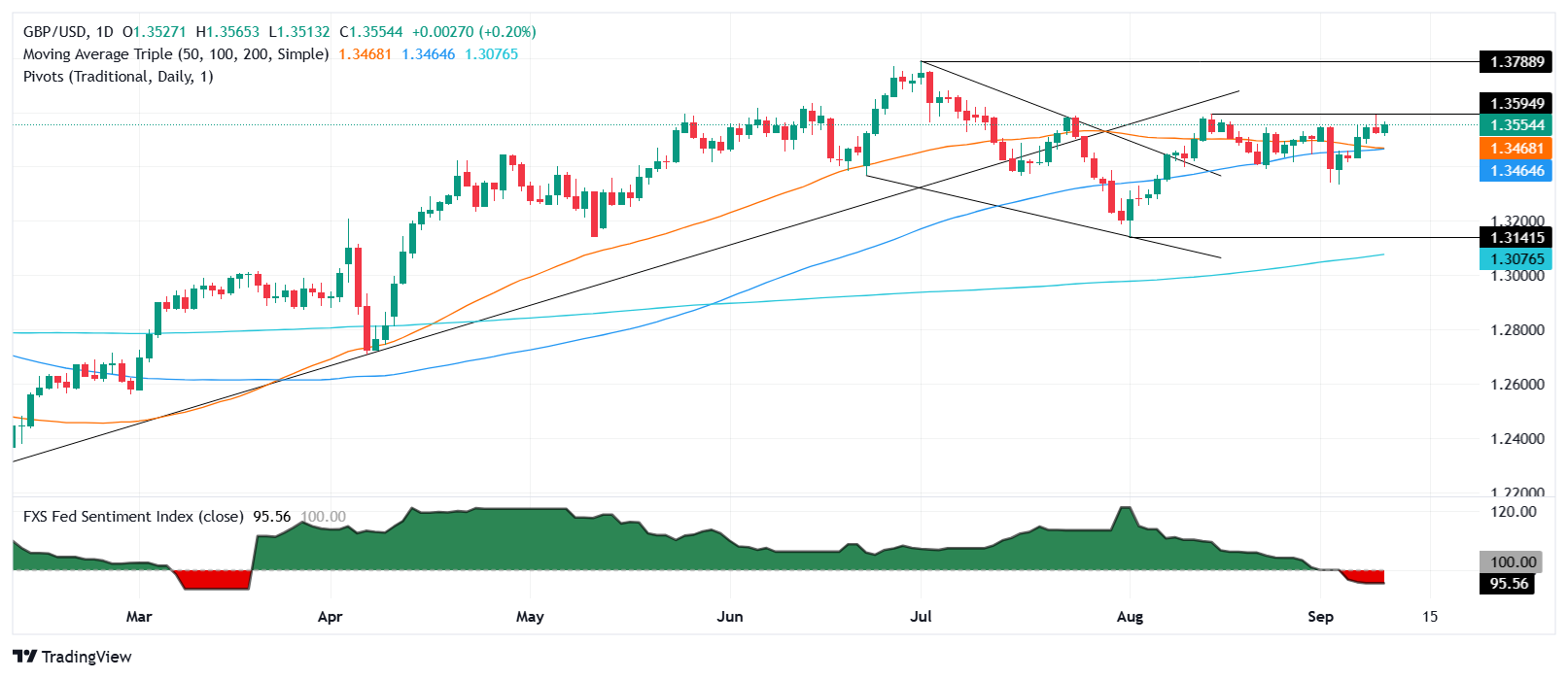GBP/USD holds near 1.3550 as soft US PPI boosts Fed cut bets

- Sterling hovers around 1.3550 as focus shifts to US CPI and Jobless Claims.
- US PPI cools sharply in August, headline down to 2.6% YoY, core easing to 2.8%, fueling Fed cut speculation.
- BoE expected to hold rates steady at 4%, while UK fiscal challenges cap Sterling’s upside potential.
The GBP/USD hoovers around the 1.3550 figure for the third straight day after the latest inflation report in the United States (US) showed that prices paid by producers dipped in August, increasing the chances for an interest rate cut by the Federal Reserve.
Sterling steadies for third day as Dollar weakens on softer producer prices, with traders eyeing key CPI next
The US Bureau of Labor Statistics (BLS) revealed that the Producer Price Index (PPI) in August edged lower from 3.3% to 2.6% YoY. Excluding volatile items like food and energy, the so-called core PPI cooled form 3.7% to 2.8% YoY. Although the data is bearish for the Dollar, looming Consumer Price Index (CPI) figures and Initial Jobless Claims data on Thursday, are awaited by investors who are weighing the chances of a small or big size cut by the Us central bank.
Across the pond, the lack of economic data releases in the UK, keep investors adrift to developments in the US. However, high inflation prints and a difficult outlook for Britain’s finances, put a lid on Sterling’s advance.
Chancellor Rachel Reeves has been under pressure to keep the finances on track. The Autumn budget announcement is due in November.
Central bank divergence, favors further GBP upside
Next week, the Fed and the Bank of England (BoE) would host its September monetary policy meetings. The former is expected to reduce interest rates by 25 basis points to 4.00%-4.25%. On the contrary, the BoE is foreseen to hold rates unchanged at 4%.
GBP/USD Price Forecast: Technical outlook
The GBP/USD continues to consolidate at around weekly highs reached on September 9 at 1.3590, but buyers failure to decisively clear the 1.3550 area has opened the door for further downside.
The Relative Strength Index (RSI) remains bullish, but as it turns flat, the pair might remain at around 1.3500-1.3550 waiting for US CPI figures.
A breach of 1.3590 will expose 1.3600 and the next key resistance seen at 1.3681, the July 4 peak. On the other hand, a drop below 1.3500, will expose the 20-day SMA at 1.3491, followed by the 50-day SMA at 1.3465.

Pound Sterling FAQs
The Pound Sterling (GBP) is the oldest currency in the world (886 AD) and the official currency of the United Kingdom. It is the fourth most traded unit for foreign exchange (FX) in the world, accounting for 12% of all transactions, averaging $630 billion a day, according to 2022 data. Its key trading pairs are GBP/USD, also known as ‘Cable’, which accounts for 11% of FX, GBP/JPY, or the ‘Dragon’ as it is known by traders (3%), and EUR/GBP (2%). The Pound Sterling is issued by the Bank of England (BoE).
The single most important factor influencing the value of the Pound Sterling is monetary policy decided by the Bank of England. The BoE bases its decisions on whether it has achieved its primary goal of “price stability” – a steady inflation rate of around 2%. Its primary tool for achieving this is the adjustment of interest rates. When inflation is too high, the BoE will try to rein it in by raising interest rates, making it more expensive for people and businesses to access credit. This is generally positive for GBP, as higher interest rates make the UK a more attractive place for global investors to park their money. When inflation falls too low it is a sign economic growth is slowing. In this scenario, the BoE will consider lowering interest rates to cheapen credit so businesses will borrow more to invest in growth-generating projects.
Data releases gauge the health of the economy and can impact the value of the Pound Sterling. Indicators such as GDP, Manufacturing and Services PMIs, and employment can all influence the direction of the GBP. A strong economy is good for Sterling. Not only does it attract more foreign investment but it may encourage the BoE to put up interest rates, which will directly strengthen GBP. Otherwise, if economic data is weak, the Pound Sterling is likely to fall.
Another significant data release for the Pound Sterling is the Trade Balance. This indicator measures the difference between what a country earns from its exports and what it spends on imports over a given period. If a country produces highly sought-after exports, its currency will benefit purely from the extra demand created from foreign buyers seeking to purchase these goods. Therefore, a positive net Trade Balance strengthens a currency and vice versa for a negative balance.







